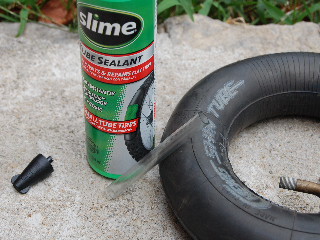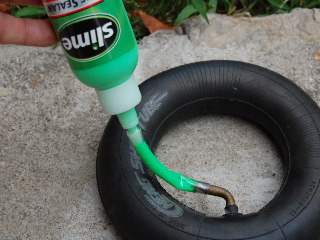
It’s Saturday morning and you’ve just finished breakfast. You put on your comfortable work clothes, grab a bottle of water, and head out the back door to the gardening storage shed behind the house.
What a great day to cut the grass! You have visions of the beautiful mowing stripes you’ll paint like an artist onto your lush lawn of hybrid fescue.
You’ve only had this deluxe new riding mower with the 18 horsepower engine and the 48 inch cutting deck a couple of months now, and it’s a pleasure to operate; “smooth as a sports car,” you tell your neighbors. You open the doors on the storage shed, look at your beautiful red turf tiger, and. . . . . .your Saturday morning balloon of joy deflates with a slow “whooosssh,” just like the right front tire of your mower has done. You’ve got a flat tire.
Your previously anticipated fun-filled task has now transformed into an unwanted chore. You struggle to remove the flattened tire and its wheel assembly from the mower, take it to the local tire service store, and pay to have your tire made plump again. How could this all have been prevented, and how can you keep it from happening again?
The answer is as close as a container of tube sealant, available for a small cost from a variety of retail locations such as lawn and garden centers, lawnmower shops, bicycle shops, automotive centers, hardware stores, and possibly even that tire service store you just left! The sealant itself is a goopy mixture, with a consistency similar to that of ranch dressing.
Inserting the sealant into your tube is a fairly simple procedure. The sealant will come with a short length of clear tubing through which you squeeze the goop into the tire stem valve. The sealant also comes with a small tool used to remove the valve core, thus enabling the product to flow easily into the tube.

When a sufficient amount of sealant has been squeezed into the tire or tube, you reinsert the valve core, inflate the tire, and spin it around a few times in order to thoroughly coat the inner lining of your tire. The sealant seeks out and seals punctures (provided they are not of a great diameter, ideally no larger than 1/8 inch).
This goopy coating on the inside of the tube should also prevent future flat tires that might be caused by punctures from small objects like nails or tacks; or especially in the case of lawnmower tires, punctures from thorns, brambles, or sharp sticks.
The effect of using the sealer is much like coating the inside of the tire or tube with rubber cement; when an object penetrates the tube and is then removed, the air pressure inside the tube forces the sealant into the puncture and thus prevents further air loss. The result of this sealing action is . . . . .you guessed it, lawn mowing friends, no flat tire!
In addition to lawnmowers, the sealant is effective in the tires and tubes of bicycles, wheelbarrows, small trail bikes, ATVs, and almost any other wheeled device whose tube has a removable valve stem core for inserting the sealant.
So, do yourself a favor; stop the next flat (and the resulting headache) before it happens and ruins another day. While all your tires are still nice and “round all the way around,” go ahead and buy and install some of that good old goopy tire and tube sealant!
 It’s Saturday morning and you’ve just finished breakfast. You put on your comfortable work clothes, grab a bottle of water, and head out the back door to the gardening storage shed behind the house.
It’s Saturday morning and you’ve just finished breakfast. You put on your comfortable work clothes, grab a bottle of water, and head out the back door to the gardening storage shed behind the house.
 When a sufficient amount of sealant has been squeezed into the tire or tube, you reinsert the valve core, inflate the tire, and spin it around a few times in order to thoroughly coat the inner lining of your tire. The sealant seeks out and seals punctures (provided they are not of a great diameter, ideally no larger than 1/8 inch).
When a sufficient amount of sealant has been squeezed into the tire or tube, you reinsert the valve core, inflate the tire, and spin it around a few times in order to thoroughly coat the inner lining of your tire. The sealant seeks out and seals punctures (provided they are not of a great diameter, ideally no larger than 1/8 inch).